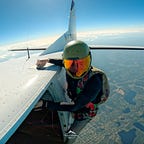Applying Data Science to Product Management to develop an MVP Launch Strategy
Recently, I have been doing some research and exploring the career option of becoming a product manager after I graduate from the MS in Electrical & Computer Engineering program at Carnegie Mellon University.
I came across Udacity’s Data Product Management Nanodegree (DPMND) and I when I was self-learning PM basics. I was captivated by the idea of fusing data science principles, data engineering processes and market experimentation tests with product management to build products that are more personalized, likable and would create more lasting impacts in target user groups. I did not hesitate to sign up for the course, and I have acquired a taste of what it is like to serve as a product manager.
DPMND Case Study
In this nanodegree program, I worked as a data product manager for Flyber, the first flying taxi service provider in the New York City. There are four key steps I took to help Flyber launch its product to the market:
Step 1: I analyzed data collected by Flyber from both user research and flying taxi operations data by leveraging SQL and Tableau. I helped Flyber identify perspective customers and their pain points, and understood the user and market impact that a flying taxi service could bring to the society.
Step 2: I synthesized insights acquired from preliminary data analysis, and drafted a data-backed product proposal. I developed a product vision, product objective, and KPIs for Flyber. I helped determine feature set for the minimum-viable-product (MVP) of the flying taxi car service.
Step 3: I helped Flyber develop a scalable data strategy to handle the exponentially increasing amount of data, and performed the necessary extraction and transformation of the data to derive business insights for helping Flyber grow.
Step 4: I processed and analyzed a larger set of Flyber’s customer data, and defined customer segments/behavioral dimensions and relevant new product feature opportunities. I constructed hypotheses for new product features of the Flyber app and launched an A/B/n experiments to validate these hypotheses.
This case study will be presented by a series of four articles, while this first article will focus on step 1 & step 2 of my capstone project, which address the topic of developing an MVP Launch Strategy.
UX Research & Brainstorming
Flyber has provided a customer research dataset of 500 samples. The dataset includes customer features such as:
- Age
- Level of income
- Gender
- Place of residence
- Whether or not the customer currently uses taxi or ride-sharing service
- Would the customer be open to use a flying taxi service, if such a concept existed? (Y/N)
- If yes to Q6, how much would the customer be willing to pay per mile for such a service? (USD)
- If no to Q6, what is the reason?
Analyzing the user research data allows us to deep dive into customer behaviors to better understand target users. Therefore, I began by asking myself some basic questions to guide my analysis:
- What are taxis used for?
- What are the characteristics of the users that leverage them?
- What are existing pain points with taxis?
- What are the existing pain points with digital ride-sharing services?
And here are my thoughts:
- Taxis exist to provide a mean of public transportation that can get passengers to a specific location of choice.
- Customers that leverage taxis likely have the following characteristics: viewing convenience as an important factor in transportation (so money may not be the issue); do not possess their own vehicles; are not capable of driving or do not have the license to drive.
- Existing pain points with taxis: passengers can not schedule taxis service ahead of time online (unpredictable); cannot solve the traffic congestion issue during rush hours.
- Existing pain points with digital ride-sharing services: just like taxis, they also cannot solve traffic congestion.
What are the user and market improvements that Flyber could bring?
- Overall, I have identified that Flyber’s service would yield a tremendous impact in helping to resolve the notorious congestion issue by providing a mean of air-based transportation.
- The biggest user improvement that a flying taxis service would offer to the customers is the tremendous reduction in transportation time, especially during rush hours.
- A dramatic decrease in air pollution resulted from vehicles is also expected to see when electricity-powered copters emerge.
- More importantly, business professionals who used to waste a vast amount of time on commuting to work during rush hours could experience much less frustration, because Flyber could help them make a much better use of their wasted time: converting the long and tedious commute time into time to spent with family or productive hours at the workplace that could have been devoted to build a better world.
In the next step, I will conduct extensive analysis on both the quantitative and qualitative data to deep dive into customer needs, and build and launch a data-backed minimum-viable-product (MVP) strategy for Flyber’s business. Stay tuned!
